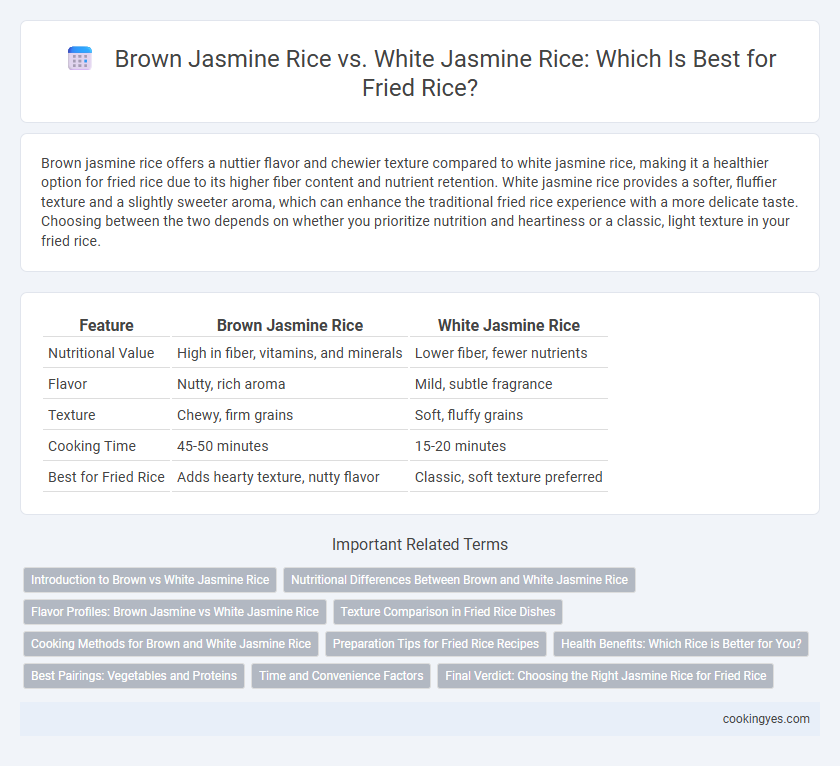Brown jasmine rice offers a nuttier flavor and chewier texture compared to white jasmine rice, making it a healthier option for fried rice due to its higher fiber content and nutrient retention. White jasmine rice provides a softer, fluffier texture and a slightly sweeter aroma, which can enhance the traditional fried rice experience with a more delicate taste. Choosing between the two depends on whether you prioritize nutrition and heartiness or a classic, light texture in your fried rice.
Table of Comparison
| Feature | Brown Jasmine Rice | White Jasmine Rice |
|---|---|---|
| Nutritional Value | High in fiber, vitamins, and minerals | Lower fiber, fewer nutrients |
| Flavor | Nutty, rich aroma | Mild, subtle fragrance |
| Texture | Chewy, firm grains | Soft, fluffy grains |
| Cooking Time | 45-50 minutes | 15-20 minutes |
| Best for Fried Rice | Adds hearty texture, nutty flavor | Classic, soft texture preferred |
Introduction to Brown vs White Jasmine Rice
Brown jasmine rice retains its bran and germ layers, providing higher fiber content, essential nutrients, and a nuttier flavor compared to white jasmine rice. White jasmine rice undergoes milling and polishing processes that strip away these layers, resulting in a softer texture and quicker cooking time favored in traditional fried rice recipes. Choosing between brown and white jasmine rice impacts the nutritional profile and taste of fried rice, with brown rice offering a heartier, more textured dish and white rice delivering a lighter, fluffier outcome.
Nutritional Differences Between Brown and White Jasmine Rice
Brown jasmine rice retains its bran and germ layers, providing higher fiber content, essential vitamins like B-complex, and minerals such as magnesium compared to white jasmine rice. White jasmine rice undergoes milling and polishing, which removes these nutrient-rich layers, resulting in lower fiber and micronutrient levels but a softer texture preferred in certain fried rice dishes. Choosing brown jasmine rice for fried rice enhances nutritional value by offering complex carbohydrates and antioxidants that support digestion and steady energy release.
Flavor Profiles: Brown Jasmine vs White Jasmine Rice
Brown jasmine rice offers a nuttier, earthier flavor with a slightly chewy texture, enhancing the depth of fried rice dishes. White jasmine rice delivers a delicate, subtly sweet aroma and a softer, fluffier consistency that absorbs sauces well, making it ideal for traditional fried rice. The choice between the two depends on whether a richer, heartier taste or a lighter, fragrant base is preferred.
Texture Comparison in Fried Rice Dishes
Brown jasmine rice maintains a firmer, chewier texture in fried rice dishes due to its intact bran layer, providing a more substantial bite compared to white jasmine rice. White jasmine rice yields a softer, fluffier texture that easily absorbs sauces and seasonings, resulting in a light, delicate mouthfeel. The choice between brown and white jasmine rice depends on whether a hearty or tender texture is preferred in the fried rice preparation.
Cooking Methods for Brown and White Jasmine Rice
Brown jasmine rice requires a longer cooking time and more water due to its intact bran layer, which makes it chewier and nuttier in texture. White jasmine rice, being polished and softer, cooks faster with a fluffier, stickier consistency ideal for traditional fried rice dishes. Achieving perfect fried rice involves rinsing white jasmine rice to remove excess starch, while brown jasmine rice benefits from soaking to ensure even cooking and better texture retention.
Preparation Tips for Fried Rice Recipes
Brown jasmine rice requires a longer soaking time and slightly more water to achieve the ideal firmness for fried rice, ensuring each grain remains separate and chewy. White jasmine rice absorbs flavors quickly, so using slightly less oil and cooking over medium-high heat helps prevent clumping and ensures a fluffy texture. For both types, cooling the rice completely before stir-frying enhances the best separation and texture in fried rice recipes.
Health Benefits: Which Rice is Better for You?
Brown jasmine rice offers more health benefits for fried rice compared to white jasmine rice due to its higher fiber content, which aids digestion and promotes satiety. It retains essential nutrients like magnesium, phosphorus, and B vitamins that are lost during the milling process of white jasmine rice. Choosing brown jasmine rice can support better blood sugar control and sustained energy levels, making it a healthier option for fried rice dishes.
Best Pairings: Vegetables and Proteins
Brown jasmine rice's nutty flavor and chewy texture pair well with robust vegetables like bell peppers, broccoli, and snap peas, enhancing the dish's overall earthiness. White jasmine rice's soft, fragrant grains complement tender proteins such as shrimp, chicken, and tofu, absorbing sauces and spices effectively for balanced fried rice. Both varieties work excellently with eggs and green onions, creating a harmonious blend of flavors and textures.
Time and Convenience Factors
Brown jasmine rice requires a longer cooking time, typically about 40-45 minutes, which can delay meal preparation compared to white jasmine rice that cooks in approximately 15-20 minutes. White jasmine rice offers greater convenience for fried rice dishes due to its quicker cooking process and softer texture, which allows for easier stir-frying. While brown jasmine rice provides more fiber and nutrients, its extended cooking time makes white jasmine rice the preferred choice for time-sensitive fried rice recipes.
Final Verdict: Choosing the Right Jasmine Rice for Fried Rice
Brown jasmine rice offers a nuttier flavor and higher fiber content, enhancing the nutritional value of fried rice, while white jasmine rice provides a softer texture and more neutral taste, ideal for absorbing sauces and spices. For optimal fried rice, white jasmine rice is preferred due to its fluffy consistency and ability to stay separate when stir-fried. Choosing between brown and white jasmine rice depends on your priorities for texture and health benefits, with white jasmine rice being the classic choice for traditional fried rice recipes.
Brown jasmine rice vs White jasmine rice for fried rice Infographic

 cookingyes.com
cookingyes.com